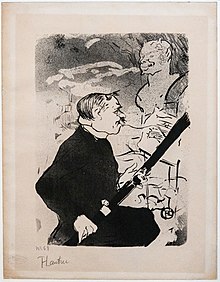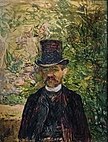Désiré Dihau
Désiré Dihau | |
|---|---|
 Les Vieilles Histoires... Pour toi ! Portrait of Désiré Dihau (1893) Lithograph by Henri de Toulouse-Lautrec | |
| Born | Désiré Hippolyte Dihau 2 August 1833 |
| Died | 20 August 1909 (aged 76) Paris |
| Occupation(s) | Bassoonist Composer |
Désiré Dihau (2 August 1833 – 20 August 1909) was a French
Biography
Désiré Hippolyte Dihau was born 2 August 1833 in
He is best known for being the bassoonist of the Paris Opera, where he played from July 1, 1862, to December 31, 1889, immortalized by
In the early 1890s, Dihau composed melodies for his poet friends like

For the cover of the Vieilles Histoires, subtitled "répertoire mondain", a collection of poems by
Toulouse-Lautrec also painted two portraits of Désiré Dihau in 1890 and 1891: the first, simply titled Désire Dihau, shows Dihau sitting three-quarter back, reading a newspaper;[10] The second, entitled Monsieur Désiré Dihau, basson de l'Opéra, represents the musician standing, in front bust, in suit and top hat.[11][2] The two portraits were drawn in the garden of Père Forest (rue Forest), as was a portrait of Henri Dihau, brother of Désiré and Marie[12][5] and kept at the musée Toulouse-Lautrec of Albi.
As for the Degas, they were hung in the living room of the Dihau and then, after Désiré's death in 1909, in the modest apartment that his sister occupied rue Victor Massé
The charming old lady lived on a small income and produced music lessons she gave, often for free, to the girls of Montmartre who were preparing to sing in the cafés.[4]
For lack of money, she sold her first portrait painted by Degas at the Metropolitan Museum of Art in New York in 1922. Not wanting to part with the other two Degas paintings she owned, The Opera Orchestra and her portrait on the piano, she gave them to the Musée du Luxembourg in 1923, subject to usufruct and the payment of an annual rent of 12,000 francs, financed by David David-Weill for L'Orchestre and Marcel Guérin (art critic) for the portrait. Faced with the enthusiasm raised during an exhibition in 1924 at the Galerie Petit, by the two works, which had never before been shown to the public, apart from a few artists and some relatives of the Dihau like Toulouse-Lautrec, the contract was bought by the Louvre where they were exhibited after the death of Marie Dihau in 1935. They were transferred to the Musée d'Orsay in 1986.[4]
Désiré Dihau died in Paris 20 August 1909.[1]
Gallery
-
Mr. Désiré Dihau, basson de l'Opéra -Toulouse-Lautrec1891
-
Degas, Musiciens à l'orchestre (the Städel, 1872)
-
Degas, Le Ballet de "Robert le Diable" (Metropolitan Museum of Art, 1871)
-
Degas, Le Ballet de « Robert le Diable » (Victoria and Albert Museum, 1876)
-
Mademoiselle Marie Dihau (Metropolitan Museum of Art, 1967–1968)
-
Mademoiselle Dihau au piano (Degas) (musée d'Orsay, 1869)
-
Mademoiselle Dihau au piano (Toulouse-Lautrec) (Musée Toulouse-Lautrec, 1890)
References
- ^ a b (in English) Hélène Couturier, « About Degas' L'Orchestre de l'Opera », International Double Reed Society, volume 8, n° 1, translation Philip Gottling, Association Les Amis du basson français, bulletin n° 9, March 1983 (read online) Archived 2017-02-02 at the Wayback Machine
- ^ a b c (in English) Mindy Keyes, « Degas, Toulouse-Lautrec and Désiré Dihau: Portraits of a Bassoonist and his Bassoon », International Double Reed Society, volume 13, n° 2, spring 1990 (read online) Archived 2016-07-29 at the Wayback Machine
- ^ Edgar Degas, « Musicians in the Orchestra (Portrait of Desire Dihau) » (1870, Fine Arts Museums of San Francisco). (read online).
- ^
- ^
- ^ Gallica
- ^ « Judic and Dihau (The Fitting of the Corset) », scholarsresource.com (read online)
- ^ « Le monde de Lautrec : Dihau Désiré », toulouselautrec.free.fr (read online)
- ^ Henri de Toulouse-Lautrec, Désiré Dihau (Lautrec) (1890), musée Toulouse-Lautrec (read online) Archived 2017-02-06 at the Wayback Machine
- ^ Henri de Toulouse-Lautrec, Monsieur Désiré Dihau, basson de l'Opéra (1891), musée Toulouse-Lautrec (Read online).
- ^ (in English) Jardin Père Forest, toulouselautrec.over-blog.com (read online) Archived 2017-02-06 at the Wayback Machine
External links
- Désiré Dihau biography and portraits
- Désiré Dihau Archived 2017-02-06 at the Wayback Machine in Musée Toulouse Lautrec
- Désiré Dihau's discography on Discogs
- (in English) Degas, Toulouse-Lautrec and Désiré Dihau Portraits of a bassoonist and his bassoon








